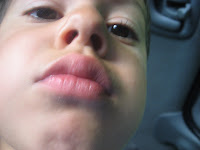If you do have a weak stomach or difficulty adjusting to new foods, the milk products are probably the ones to avoid at first. The milk that you buy in a mass manufactured container from the supermarket is no different than what we drink in the
The guy who brings raw milk to my neighborhood drives it up in the canteros (the silver containers it comes in from the dairy) and honks his horn to let everyone know he has arrived. You have to bring out your own container, nothing is prepackaged. It costs 8 pesos a litter, so naturally it is somewhat of a luxury item. When this milk comes in, the first thing we do is separate it into a couple of smaller metal containers and put those in the fridge. This lets the cream rise to the top where it can be skimmed off to make jocoque. A common confusion in vocabulary is that sour cream as we know it in the
Chongos
Our quest for Chongos began several months ago when we came down in November. We travelled to a dairy in
“We’re here.” Jose Manuel replied calmly. At this point, we made a 90 degree turn onto a dirt road from an interstate with a 110 km/hour speed limit. Nobody blinked an eye. Apparently, the exit that could be taken to go to
We pulled into the dairy and I was hit with an odor that can only be described as pungent. 50 – 60 cows were waiting for their turn at milking and food. I watched as two men, positioned on low, three legged stools milked cows whose backlegs had been tied together to prevent kicking. The cows didn’t seem to mind at all. It was not work for the faint of heart and I must admit I was a bit disturbed by the number of flies present. A huge bull who was tied off in the corner eyed us all suspiciously and I found myself trying to remember anything from physics class that would let me ascertain the chances that he could pull loose from the tie.
We got something like 40 liters of milk and a special substance called “el cuajo.” Cuajo is rennet, the acid from the lining of a cows stomach. When half a cap of this liquid is added to 40 liters of milk, it causes the milk to separate and the curds are then collected for the chongos. Unfortunately, we left the cuajo in a borrowed truck and were unable to get it back until the next morning by which time the fresh milk had already turned (it was too much to keep in the refrigerator). My mother-in-law made a valient effort to make chongos anyway but what we ended up with was a very large tub of spoiled milk and it all had to be thrown away.
This time, we appointed my husband as official “keeper of the cuajo” and made a point of asking him approximately every thirty seconds if he still had the stuff in sight. We returned to the same dairy where it was no less fascinating to watch these men milk the cows. It’s a family business and the father who at 42 already had a six year old grandchild told me that they work 365 days a year from about 6:00 am until 9:00 pm at night.
“It’s a job that makes you old.”
They have about 50 – 60 cows and their dairy produces approximately 1,200 liters (or 300 gallons) of milk a day. This time they had some mechanized milking equipment and the father milked with the pumps while the son milked by hand. The noise from the milking machine was nearly deafening. While he was cleaning the equipment, the father complained that business was getting harder as the price of feed was increasing faster than the price of the milk. After the last cow had been hearded out of the milking shed, one stood looking in and mooing in a high, desperate tone. This cow was expecting and they told me they can only milk her in the morning but she’s used to the schedule and wants her evening milking.
We bought 15 liters of milk and put it in a sports cooler, like the kind filled with gatorade at football games. At 5 pesos per liter, it felt like a pretty good deal. We bound the cooler in the back of the pick up truck. loaded our human cargo back in (this time, only 12 people) to go back up to the van, and to buy more cuajo. We went to an unmarked building that was the cheesemaker’s shop in
So, this morning, my mother-in-law showed me that the milk had separated and when I left the house, she was pulling out handfuls of whey and putting them in another container. I have no idea what to expect from this but I know it involves a lot of cinamon

















